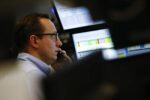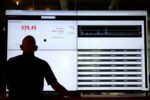Earnings call: Siltronic AG charts steady course amid market uncertainties


© Reuters.
In its annual results presentation for the 2023 financial year, Siltronic AG (WAFGn), a leading wafer manufacturer, discussed its performance, future outlook, and strategic initiatives. Despite a 16% decline in sales to EUR 1.5 billion and a challenging wafer demand environment, the company achieved a solid EBITDA margin of 29%.
Siltronic announced the appointment of Klaus Buchwald as Chief Operating Officer and confirmed its midterm targets for 2028. The company anticipates a significant but uncertain turnaround in wafer demand, forecasting a 7% to 8% increase in 2024, with expectations of a stronger second half.
Siltronic also proposed a reduced dividend of EUR 1.2 for the past financial year and highlighted its sustainability efforts, including a 22% reduction in carbon emissions since 2021, with a goal to further decrease emissions by 42% by 2030.
Key Takeaways
- Siltronic AG’s sales decreased by 16% to EUR 1.5 billion in 2023, with a solid EBITDA margin of 29%.
- Klaus Buchwald appointed as Chief Operating Officer.
- Midterm targets for 2028 reaffirmed, despite current market uncertainties.
- Company expects a 7% to 8% increase in wafer demand in 2024, with a stronger second half anticipated.
- Dividend for the past financial year proposed at EUR 1.2.
- Significant sustainability efforts underway, including a 22% reduction in carbon emissions since 2021.
Company Outlook
- Turnaround in wafer demand expected, particularly in server and automotive sectors.
- First half of 2024 likely to be pressured by large chip manufacturer inventories.
- Sales for 2024 projected to be in line with 2023, with stable average selling prices.
- New fab in Singapore to positively impact margins when demand increases.
- Refinancing plan in place, with a conservative approach to liquidity reserves.
Bearish Highlights
- Uncertainty around the timing of the market demand turnaround.
- Large inventories at chip manufacturers may dampen demand in the near term.
- No guidance provided on tax rate due to declining profit before tax.
- Ramp-up costs for FabNext to start affecting financials from Q2.
Bullish Highlights
- Long-term agreements (LTAs) and 300-millimeter core activities expected to support stable average selling prices.
- Company differentiated in the 200-millimeter segment, with less competitive pressure.
- Geopolitical situation favoring established Western and other non-Chinese wafer suppliers.
Misses
- Sales for 2023 fell by 16% compared to the previous year.
- Dividend reduction proposed due to past financial performance.
Q&A Highlights
- Syn loan is a variable loan, with refinancing options being explored.
- No major LTAs expiring this year; efforts to improve EPI polish mix.
- Convertible refinancing considered but not a priority.
- Company to maintain conservative financing and liquidity reserve strategy.
- Dividend policy to remain, with the caveat that a negative EPS would result in zero dividend.
By maintaining a neutral tone and focusing on the facts, this article offers a comprehensive overview of Siltronic AG’s earnings call, providing investors with clear insights into the company’s performance and outlook.
Full transcript – Siltronic AG (WAFGn) Q4 2023:
Operator: Good morning, everyone, and welcome to the presentation of Siltronic Annual Results for the ’23 Financial Year. Please note that this call is being recorded and streamed on the Siltronic’s website. The call is also be available as an on-demand version later today. Your participation in this call implies on your consent with this. At this time, it would be my pleasure to turn the conference over to Verena Stutze, Head of Investor Relations and Communications of Siltronic AG. Please go ahead, ma’am.
Verena Stutze: Thank you, Francie. Welcome everybody to our full year ’23 results presentation. This call will also be webcast live on siltronic.com. A replay of the call will be available on our website shortly after the end of the call. Our CEO, Michael Heckmeier; and our CFO, Claudia Schmitt will give you an overview of the management team, our financials, our guidance and the current market development. After the presentation, we will be happy to take your questions. Please note that management comments during this call will include forward-looking statements which involve risks and uncertainties. For a discussion of risk factors, I encourage you to review the Safe Harbor statement contained in today’s press release and presentation. All documents relating to our full year ’23 reporting are available on our website. I now turn the call over to Michael for his remarks.
Michael Heckmeier: Thank you, Verena and a warm welcome also from my side. I would like to start today’s call with an Executive Board topic. Siltronic has ambitious growth plans, and would therefore also adopt its leadership structure and organization to be ready to deliver on this promise. Therefore, I am pleased to announce that the Supervisory Board has appointed Mr. Klaus Buchwald to the Executive Board of Siltronic AG with effect from 1st August this year. He will assume the position of Chief Operating Officer. Mr. Buchwald has been appointed for an initial period of three years and will primarily be responsible for operations and supply chain, engineering and IT. Klaus is 55 years old, holds a degree in mechanical and industrial engineering, has been working with Infineon (OTC:) for more than 21 years, most recently as Senior Vice President, Operations of their Green Industrial Power division and Executive Vice President, Corporate Supply Chain. Thanks to his in-depth knowledge of the semiconductor industry and the value chain, he is the ideal addition to our Executive Board. Throughout his professional career, he has successfully developed and implemented digitalization initiatives, including the implementation of AI in operations. Please join us in welcoming Klaus to the Siltronic team. Let’s move on to the next slide with a brief summary of today’s key messages. Mission accomplished is the message related to our performance in ’23, where we were able to achieve a solid margin despite significant decline in wafer demand. Even though in ’24, the end markets will see some pickup, there are still some large inventory levels particularly at our customers. This leads to an uncertain environment for financial guidance. Nevertheless, we are ready to harvest the expected market upswing, which will be driven by megatrends. And we confirm our midterm targets for ’28 that we presented to you at our Capital Markets Day in November with a sales ambition of more than EUR 2.2 billion and an EBITDA margin target in the high 30s. I would like to continue with a brief glance on our ’23 figures, which will be presented to you by Claudia in a minute. Our full year sales, EBITDA margin and CapEx were within our guidance. We were able to keep a stable ASP despite the mentioned volume drop. Due to the ongoing market weakness and the upcoming refinancing discussions, the Executive Board proposes to the AGM to reduce the dividend for the past financial year to EUR 1.2 as already communicated on February 12. Claudia will now give you a deep dive into our KPIs before I report back with some updates on the market development and the outlook for ’24 and beyond. Claudia, please.
Claudia Schmitt: Thank you, Michael. A warm welcome also from my side. In the next few minutes, I will present an overview of our financials. At the end of my speech, I will provide you with an update on our sustainability development. Now let’s jump directly into the analysis of our results which I continue to characterize as solid in a challenging environment. As Michael mentioned before, our 2023 figures were in line with our guidance. Sales decreased by 16% year-on-year to EUR 1.5 billion mainly due to a significant volume decline caused by the high inventories at our customers and OEMs. Therefore, it’s even more positive that on our ASP on the euro base remains stable compared to 2022. Some negative FX effects were offset by slightly positive mix and price effects. In Q4, sales increased by 2% quarter-on-quarter as a result of a product mix shift. Volume and FX impacts were neglectable. Our EBITDA ’23 came in at EUR 434 million. The EBITDA margin reached a robust 29% level. However, this was significantly lower than the adjusted 34% in ’22, excluding the onetime income of EUR 50 million from the GlobalWafers tender offer. The main reasons for this decline were, on the one hand, the lower volumes which resulted in a decreased fixed cost dilution. On the other hand, as previously announced, we had to deal with inflation driven cost increases of roughly EUR 30 million year-on-year. Raw materials supplies and labor tariffs were up. But on a positive note, we saw some declining trends in freight charges and energy cost as a net effect of lower prices in Germany and higher prices in Singapore. The cost impacts mainly occurred in the first half of the year. In H2, the cost remained largely on H1 level. But nevertheless the full year impact was around minus 2 percentage points on our EBITDA margin. A tailwind on our ’23 EBITDA came from a favorable FX result of EUR 17 million mostly from currency hedges, benefiting from very positive FX environment at the time of the hedges. On a quarterly basis, as already expected, the positive FX impact of EUR 10 million in Q3 was not repeated in Q4 where we’ve recorded minus EUR 1 million. Therefore, the Q4 margin came in lower at 25.5%. Looking into ’24, please do not expect a similar positive hedging result as in ’23. We forecast the positive impact from lower energy and material cost, but this will be compensated by a lower hedging result and rising labor tariffs. The EBIT ’23 decreased to EUR 231 million year-on-year, reflecting a higher depreciation, mainly as a result of our investment activities in Germany. Our financial result ’23 was close to 0, but I would like to give a brief explanation as we have seen opposing trends here. On the one hand, we had a high income from financial investments due to a favorable condition in the capital markets. On the other hand, our record spending has substantially reduced our cash and securities over the course of the year and the interest expense on debt has constantly increased. Those developments will continue into 2024. The tax rate for ’23 was ultimately 13%, but we saw strong fluctuations between the quarters which were driven by the site mix and deferred taxes. With all these effects, the net income 2023 reached EUR 201 million. Looking at our balance sheet, total assets summed up to roughly EUR 4.5 billion by the end of ’23. The changes compared to the previous year are mainly caused by our high investments. In ’23, CapEx totaled EUR 1.3 billion. As a result, our fixed asset share increased from 58% to 77%. Consequently, our cash and securities have significantly decreased from more than EUR 1 billion end of ’22 to less than EUR 500 million end of ’23. Our working capital ratio at the end of last year was at an all-time low. This was driven by favorable DSO in Q4, a decrease in receivables due to the lower sales level and the CapEx related increase in trade tables. Looking into ’24, we will likely see the opposite effects. Trade receivables higher and trade payables significantly lower as we will reduce the CapEx related overhang from ’23 along with the significantly lower CapEx level. The equity ratio is at a very healthy level of 47%. Financial liabilities in ’23 increased year-on-year as we have drawn the last installment of our Singapore dollar loan in Q3. Therefore, loans amounted to a total of roughly EUR 800 million at the end of last year. In the reporting year, we’ve received customer prepayments of EUR 79 million and EUR 40 million were refunded. Total prepayments at the end of December amounted to EUR 589 million. 2023 was the peak of our investment phase with a total CapEx of EUR 1.3 billion. This included FabNext project in Singapore, the expansion of the crystal pulling hall at Freiberg and our steady state CapEx. FabNext will continue to be the core area of our investment in ’24, but the total CapEx level will reduce to below EUR 600 million, driven by a planned reduction in project spending and a more pronounced focus on CapEx management. Let’s take a closer look at our cash and debt situation by looking at the bridge on the left side. At the end of ’22, Siltronic had net financial assets of EUR 374 million. We generated a solid operating cash flow of EUR 488 million in ’23, which was lower than the high CapEx and dividend payments. In Q4, we’ve received an investment grant of EUR 84 million, which positively influenced our cash flow. In total, our net financial assets turned into net financial debt of EUR 356 million. A note for your cash flow model 2024. As already mentioned, CapEx related payables were very high at the end of ’23. We expect to reduce this overhang significantly. This means that payments for CapEx in ’24 will clearly exceed the indicated investment level. And regarding the investment grant, there will be another tranche of roughly EUR 30 million in Q1 ’24. A short wrap-up of our financing situation. You already know this picture from our Capital Markets Day. The Syn loan here, the light blue part will be drawn this year. From ’24 onwards refund of our customer prepayments will exceed the inflow and from ’25 onwards, we will start to repay our debt financing. Despite our significant reduction in CapEx in ’24, we still expect a clearly negative net cash flow this year, driven by the muted wafer demand, an increase in working capital and still high payments for CapEx. We will, therefore, have a refinancing need in ’24, and we will now start to determine our refinancing options. And to anticipate the question, we currently have no plans for our capital increase. Now I’d like to touch on a topic that is becoming ever more important, sustainability. On the sustainability dashboard, you can see our ongoing commitment to environmental responsibility. Let’s dive into our progress. We’ve been working actively to reduce our carbon footprint, resulting in a noteworthy 22% reduction in Scope 1 and 2 emissions since 2021. However, our journey towards achieving our ambitious target of 42% reduction until 2030 is ongoing and will be even more challenging with the start of operations at FabNext. Our main levers are: Firstly, the purchase of renewable energy. Example here is our solar power purchase agreement, which started in January this year. Secondly, the in-house generation of renewable energy, our solar plant at our site in Portland will start commissioning in Q2. And thirdly, the reduction of specific energy consumption. For instance, with the adjustment of cooling water requirements and the optimization of production processes, sustainable reductions have been achieved in recent years. Water usage intensity is the ratio between the amount of water used in production to the wafer area. The large share of water consumption is independent of production volume. Although, we had a lower loading in ’23, and FabNext was under construction, we achieved a reduction of minus 1%. Given the fact that in 2022 at full utilization, we already achieved a 14% reduction, we are very optimistic for our future declining trend. Regarding the circular economy, significant advancements have been made, meaning that we are already halfway to our goal. With this, I hand back to Michael.
Michael Heckmeier: Thank you, Claudia. Ladies and gentlemen, let’s now take a look at the short and midterm outlook for industry and Siltronic. We are very confident that there will be a significant turnaround and upturn in demand for wafers in the near future. But unfortunately, the timing of this remains still uncertain. At least for the first half of ’24, as wafer supply is still confronted with large inventories of chip manufacturers, almost offsetting end market growth for the time being. This is reflected in the information on the next slide. When looking at the end markets, wafer demand is expected to increase by 7% to 8% in ’24. Encouragingly, all end markets are anticipated to expand. The highest growth rates are forecasted for servers fueled by AI and in the automotive sector where electromobility is a key driver. However, the impact of excess inventories, particularly at our customers dampens this growth, resulting in a more modest overall increase of about 2%. Although, there are signs that the demand will pick up in the second half of the year, there is still great deal of uncertainty. We still do not know when we will see the turnaround in our industry. And as stated several times before, we will not see — we will not be the first to see it since the typical time lag for the wafer industry is approximately 2 quarters after the end markets improve. Let’s now take a closer look at our market assessment for the 3 wafer segments in our most important market channels. Whilst memory is improving slowly, NAND slower than DRAM, which is driven by high bandwidth memory through AI, the inventory situation in logic is still elevated, but getting closer to normal levels. The power segment continues to cause problems with rising inventories. Be reminded that those segment dynamics are complemented by individual customer patterns and the picture for this can deviate substantially due to inventory mix and valuation. All in all, still a mixed bag and we all have to keep a very close eye on developments. Looking beyond ’24, we continue to expect a dynamic upward trend for overall wafer demand and, in particular, for our key segment of 300-millimeter and power wafers. For 200-millimeter, we expect a small growth and for diameters up to 150-millimeter, a decline. But as you know, these are small and not strategic for us. I’m sure you’re all familiar with this chart and the megatrends that are expected to drive the upward trend. After our record investment in ’23, we are set and ready to harvest as soon as we see the market turnaround based on our global production footprint. We continue to be very pleased with the progress of our new state of the art 300-millimeter fab in Singapore. Commissioning has begun and several thousand wafers have already been shipped to customers mostly for qualification purposes. D&A will start beginning of Q2 and production is ramping up according to our communicated ramp plan. Like in every new fab ramp, there are substantial ramp costs, for example, for labor, material and energy, which will burden our EBITDA margin by up to 3 percentage points in 2024. This quantifies our qualitative remarks during our CMD in November. With high cost efficiency and expected EBITDA margin of more than 50%, which will come, which will have an increasingly positive impact on our group margins, Singapore will continue to be one of our key value drivers once market demand picks up as forecasted. Let’s now turn to the guidance for the business year ’24, which we already announced 4 weeks ago. Due to the ongoing weakness in demand, we expect ’24 sales to be in the region of ’23. The first 6 months of ’24 are likely to be affected mostly by the postponement of delivery volumes, meaning that sales for this reporting period are expected to be around the level of H2 ’23. The forecast is based on the euro U.S. dollar exchange rate of 1.10. On a positive note, average selling price is expected to remain stable. The EBITDA margin before end cost will also be in the region of the previous year. As indicated, the ramp of our production in Singapore will reduce our margin by up to 3 percentage points. The high level of capital expenditure in recent years will nearly double depreciation compared to the previous year. As a result, EBIT will be significantly lower than in ’23. Capital expenditure will be more than halved. Today, we’ve precised our CapEx guidance to be smaller than EUR 600 million Therefore, we will realize pronounced improvement in net cash flow, although it still will remain significantly negative. I would like to conclude this presentation with confirmation of our midterm ambition for 2028. We expect a significant sales growth to more than EUR 2.2 billion and an improvement of EBITDA margin to the high 30s within the next 5 years. This confidence is driven by the increasing importance of global megatrends such as artificial intelligence, digitalization, electromobility and will lead to sharp rise in demand for semiconductors and therefore also for wafers. We are ready to harvest the growth potential with our global production network and especially due to the ramp of our highly profitable fab in Singapore. One of our USPs is being one of the technology leaders in our industry and keep our R&D focus to stay ahead in the curve. This and our strategic positions in leading edge power and 300-millimeter will enable us to drive sales and earnings growth in the future. Last but not least, we will remain a solid balance sheet and financing structure, which will continue to provide a sound foundation for future growth. Thank you all very much for your attention. With this, we close our presentation and Claudia and I will be happy to take your questions. Francie, please open the Q&A session.
Operator: [Operator Instructions] Our first question today is from Daniel Schafei from Citi.
Daniel Schafei: Good morning .Yes, I was just wondering on the sales dynamic for the first half of ’24. So looking, GlobalWafers recently guided for first Q being kind of the trough and that the second quarter should show mild growth. Do you see similar patterns going forward when you say that the first half will be under pressure? Or do you still see potential that the second quarter could be the trough as well?
Michael Heckmeier: Thank you, Daniel, for this question. We don’t quarterly sales dynamics today. And particularly, I must not comment on details from peers in industry. However, we still know that we see volume shifts back and forth and quarterly phasing is not fixed for Q1 and Q2. So we would refrain from giving more details here. But confirming that we also see H1 on the H2 level of last year and then H2 to show the increase that will comply then with the full year guidance.
Daniel Schafei: Okay. And just maybe on the reacceleration in the second half. What gives you the confidence that we will see this reacceleration in the second half?
Michael Heckmeier: Yes. It’s basically the logic we always convey. We showed the end market dynamics from other sources that we see improvement there. And then we add what we always said, the typical 2 quarters of delays to those dynamics. So that is when it will trickle down to the wafer industry, which needs to be considered in the framework of inventory situation. But that altogether gives us the idea that the second half can show the growth dynamics we explained.
Operator: The next question comes from Constantin Hesse from Jefferies.
Constantin Hesse: Hi, there. Good morning. Thank you very much for taking my questions. I have three. The first one, maybe just asked a little bit differently. What kind of risks do you see today potentially of further postponements? I mean, I do — obviously, when you read everything that’s being reported, memory seems to be improving, obviously inventories are coming down. However, you’re saying now that power inventories are going up. So based on previous experiences, I’m just wondering what is the current risk level that we could potentially see another significant postponement in volumes at this point? Or is this rather probably not going to happen from this point on? That’s the first question.
Michael Heckmeier: Constantin, I understand you ask the other questions after my answer. Is there a particular pronounced risk? I mean, when we look at customer developments, they — some of them post some revenue increase. If you watch that very carefully, it’s more price than volume based, typically. So that’s something we must not confuse. Inventories are still elevated at some of our customers. That’s a risk how quickly can that really be depleted. On the positive side, we know from previous turnarounds, once it’s picking up, it can go very quickly and deplete inventories extremely quickly. So, I would say, what we guided four weeks ago and confirmed today is, let’s say, the best knowledge pulling all this together, so I would say it’s a healthy guidance in terms of risk and — but also opportunities.
Constantin Hesse: Okay. And then the last two questions just on the Syn loan. Is this a floating rate loan or is it a fixed loan? And then on the refinancing, can you just give us an idea of how much you’re looking to refinance?
Claudia Schmitt: Constantin, this is Claudia. The Syn loan is a variable loan, so the fixed rate — the interest rates are not fixed in this loan. So on the positive note, we can benefit from, hopefully, decreasing interest level in the upcoming months. And regarding the financing — refinancing, we are just starting to check the amount, the options that we have, which will very much depend on the general environment that we see this year. We will decide as soon as we have the options on the table.
Constantin Hesse: Maybe ask differently, what is the cushion that you want to have in terms cash? Is it still EUR 500 million?
Claudia Schmitt: Yes. We don’t have a target of a certain amount. But, yes, we have conservative financing approach and we always maintain an adequate liquidity reserve. And with the, let’s say, decreasing invest level we could adjust that a bit down, but we haven’t made our minds on a fixed amount. But, yes, we are still very conservative with our approach here.
Operator: The next question comes from Gustav Froberg from Berenberg.
Gustav Froberg: Good morning, everyone. Thank you for taking my questions also. I just have two, please. The first is on ASPs. Could you explain to us a little bit the confidence you have in your ASP estimates for this year and your comments that ASPs are expected to be flat? And then second question is around mix. Q4 was up a little bit quarter-on-quarter due to mix effects. Could you talk a little bit more about some of the mix effects in the quarter and maybe how we should think about the potential to shift into a more favorable mix for 2024 as well?
Michael Heckmeier: Thank you, Gustav. ASP confidence, I think it’s a very clear situation that we currently see continue. Yes, we have our 300-millimeter core activities. And as you know substantial part of the business is covered with LTAs. And this even has some potential price increases here and there when they are going to the next level. So that’s the positive side. On the lower end of things, we have significant price pressure on the small diameters. This is small, not strategic business for us, yes. And then we have, of course, mix effects and some other small things. But in total, I mean — that is the ASP, right, is the average selling price. In total, we are pretty confident that we see a continuation of what we experienced in the last couple of quarters also into ’24. With regards to your second question, Q4, Q3 mix, we typically don’t give an awful lot of more details. But as you know, we have always the EPI polish mix, which is one of the areas where we continuously try to improve our mix to the high end. But I think we cannot talk about more details about last year Q3, Q4 effects, which were anyway not huge.
Gustav Froberg: Just a follow-up, if I may, on that. How do you see this mix developing in ’24? Could you give any comments there? Or is it same answer?
Michael Heckmeier: Yes. I mean, saying ASP is stable would include mix effects. So it’s all kind of — under that umbrella we also have small mix effects. But the key dynamics are in the different diameters as I just outlined.
Operator: The next question is from Martin Jungfleisch from BNP.
Martin Jungfleisch: Hi, good morning. I have three questions, please. The first one is just on a comment back on pricing on the LTAs. Can you disclose if you have any LTAs in 300-millimeter expiring this year? Second question is on tax rate guidance. I don’t think you have given one. So just if you could provide some color on this one. And then the final question is on refinancing. Could you also discuss a bit if your convertible would make sense or would be an option as well?
Michael Heckmeier: I’ll hand over to Claudia for the second and third question. Are there any major LTAs expiring this year? Short answer is no.
Claudia Schmitt: Okay. Then I take over for your second question regarding the tax rate guidance. We decided not to guide for tax rate this year. Why? It’s obvious that our profit before tax will decline this year and so the sensitivity of the tax rate will increase. So it’s rather difficult to make a valid guidance for this. And with the lower profit before tax also the importance of tax will decline. So with our guidance, we concentrate on the important lines in your model. And regarding the refinancing and the convertible, it’s an option, but it’s not very high in our agenda I would say.
Operator: The next question comes from Juergen Wagner from Stifel.
Jurgen Wagner: Yes, good morning. Thank you for taking my questions. Actually, it’s on the new fab mix in Singapore. How much capacity will you gain this year and next year? And yes, related to that, the 50% margin which you mentioned today for this fab EBITDA at some point, which ramp level is required to achieve that?
Michael Heckmeier: Thank you, Juergen. And ’24 capacity and ramp are exactly according to plan. So we said very clearly it will be 100-plus k wafers per month by end of ’24. We are fully on track to deliver that and are, let’s say, very nicely and positively engaged with our customers to work on qualifications. By the way, in June, we will have also, let’s say, more formal opening ceremony of that fab, which is another important milestone for us. ’24 capacity, we didn’t disclose in detail and will actually really depend on the market situation. So we said very clearly, we could continue, but we also could speed up based on market needs. And if we do significant step changes, we have the lead time of 18 months to 24 months, which then would trigger additional CapEx, additional machines. So that’s pretty much what I can say. When do we reach the 50%? It depends on the market situation, yes, but we need, of course, a substantial ramp situation to have that margin contribution. So it will not happen in ’24 and also most likely not in ’25, except we are super surprised by market developments.
Jurgen Wagner: Okay. And then, yes, a follow-up or a second question on China. What are you currently seeing with respect to local competition, so local wafer manufacturers?
Michael Heckmeier: Yes. China is a good market for us. We have quite some nice businesses there. On the other side, I don’t see a lot of change to, let’s say, competitor dynamics compared what we previously said. I mean, you know, we talk about the small diameters already in the call. Here China is very active, puts a lot of effort in small diameters and a lot of pressure on that market. So there is substantial pricing situation there, which I mentioned already. In 200-millimeters, we still feel pretty differentiated and ahead of the game with our 200-millimeters float zone activities in particular. And 300-millimeter, and especially in the high end leading-edge corner, not a lot of change, yes. So we feel it’s a long, long way to go for the Chinese to be able to deliver, let’s say, appropriate quality. And here geopolitics is even helping, let’s say, the established Western and other wafer suppliers as the Chinese industry doesn’t get advanced machines, advanced equipment, et cetera, on the chip side, which is also kind of dampening substantially advanced developments in 300-millimeter in a local — for local sense, yes. So not a lot of new dynamics here, but of course, it’s ongoing watch case for us. Currently, we are quite happy with our China business.
Operator: And the next question comes from Florian Treisch from Kepler.
Florian Treisch: Hi, good morning, everybody. Thanks for taking my question. Not too much left, to be fair. But just taking your comments around EBITDA margin, D&A ratios, it sounds to me extremely likely that you will go negative on an EPS level. So do you have any commitment on paying a dividend at all? Or does it mean 30% to 40% payout on a negative EPS equals zero dividend for ’24. Or do you have any kind of commitment towards your larger shareholders?
Claudia Schmitt: Florian, this is Claudia. We stick to our statement that we will stay to our dividend policy. That’s just this year that we made this, yes, cut off to EUR 1.20 per wafer — per share, I’m sorry. But for upcoming years, we didn’t change our dividend policy.
Florian Treisch: But you would confirm if it is a negative EPS, it would mean zero dividend?
Claudia Schmitt: That means a zero dividend, yes.
Operator: The next question comes from Marie Ganneval from Bank of America.
Marie Ganneval: Good morning. I was just wondering on the development of this ramp up cost that you see happening in 2024 having this three point impact on the EBITDA margin. Do you expect the bulk of it to be recorded more in H1 or would it be more in the gradual basis as, the fab ramps?
Claudia Schmitt: Claudia here. Yes, we’ll start depreciation for FabNext in the second quarter, so ramp up cost will show up from Q2 on and it will be distributed over the years. So there is no major impact in the first half or in the second half. It’s just a gradual development of the ramp cost.
Operator: That was our last question for today. And I hand back to Verena Stutze for closing comments.
Verena Stutze: Thank you, Francie. This concludes our Q&A session. Thank you for joining us today. Our next release date is May 2 when we will publish our Q1 results. Stay healthy and let’s talk again soon. Bye.
Operator: Ladies and gentlemen, the conference is now concluded and you may disconnect your telephone. Thank you very much for joining and have a pleasant day. Goodbye.
This article was generated with the support of AI and reviewed by an editor. For more information see our T&C.






